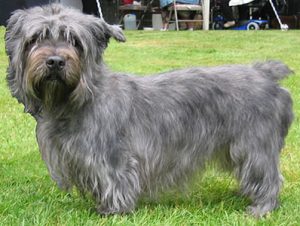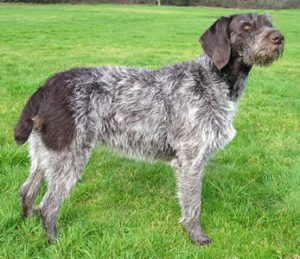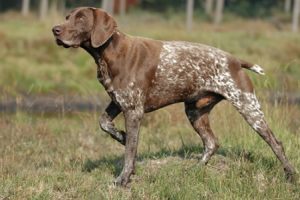
The Golden Retriever is a breed of dog, historically developed as a gundog to retrieve shot waterfowl and upland game birds during hunting and shooting parties. As such they were bred to have a soft mouth to retrieve game undamaged and an instinctive love of water. Their intelligence and versatility see them employed in a variety of roles including illegal drug detection, search and rescue, as hunting dogs, and as guide dogs. They possess a friendly, eager-to-please demeanour, and are the 4th most popular family dog breeds (by registration) in the world.
Appearance
British type
Some variations do exist between the British type Golden Retrievers prevalent throughout Europe and Australia,[9] and those of American lines and these differences are reflected in the breed standard. Its muzzle is wider and shorter, and its forehead is blockier. It has shorter legs, with a slightly deeper chest, and shorter tail. Its features make it generally heavier than the American type. Males should be between 56–61 centimetres (22–24 in) at the withers and females slightly shorter at between 51–56 centimetres (20–22 in). Their weight, however, is not specified in the UK standard. The KC standard calls for a level topline and straight hindquarters without the slight rear angulation found in American lines. The eyes of the European type are noted for their roundness and darkness as contrasted with the triangular or slanted composition of their American counterparts. A Golden Retriever of British breeding can have a coat colour of any shade of gold or cream; however, red or mahogany are not permissible colours. Originally cream was not an acceptable colour in the UK standard; however, by 1936 the standard was revised to include cream. It was felt this exclusion was a mistake as the original “yellow” retrievers of the 19th century were lighter in colour than the then current standard permitted. As with American lines, white is an unacceptable colour in the show ring. The British KC standard is used in all countries with the exceptions of the US and Canada. Some breeders of this type in America may import their dogs to improve the temperament and health noted in those bloodlines .
American type
An American Golden is lankier and less stocky than a British Type. A male should stand 22–24 inch (58–61 cm) in height at the shoulders, and females should be 21.5–22.5 inch (55–57 cm). They range in weight from 65–75 lb for males and 55–65 lb for females. The coat is dense and water repellent, in various shades of lustrous gold, with moderate feathering. The gait should be free, smooth, powerful, and well-coordinated.
Canadian type
The Canadian Golden Retriever is a newer type of Golden. Appearance is meant to be similar to the American type in height and weight, with a light coat colour. Colour is described as not as light as a British type, and not as dark as an American type. Field line Golden Retrievers tend to be smaller and have a thinner coat than their conformation line counterparts, and they are usually darker in colour.
Coat and colour
As indicated by their name, their coat comes in light golden colours to dark golden colours. The coat and undercoat are dense and waterproof, and may be straight or moderately wavy. It usually lies flat against the belly. The American Kennel Club (AKC) standard states that the coat is a “rich, lustrous golden of various shades”, disallowing coats that are extremely light or extremely dark. This leaves the outer ranges of coat colour up to a judge’s discretion when competing in conformation shows. Therefore, “pure white” and “red” are unacceptable colours like black . The Kennel Club (UK) also permits cream as an acceptable coat colour. Judges may also disallow Goldens with pink noses, or those lacking pigment. The Golden’s coat can also be of a mahogany colour, referred to as “redheads”, although this is not accepted in the British show ring. As a Golden grows older, its coat can become darker or lighter, along with a noticeable whitening of the fur on and around the muzzle. The darker a Golden Retriever is in colour, the faster it will whiten. Puppy coats are usually much lighter than their adult coats, but a puppy with a darker colouration at the tips of the ears may indicate a darker adult colour. A golden’s coat should never be too long, as this may prove to be a disservice to them in the field, especially when retrieving game.
Grooming
Golden Retrievers under adult age generally need less grooming care than adult dogs, but if a large amount of time is spent on grooming, a puppy will more likely tolerate adult grooming. Grooming tools include guillotine nail clippers on nail filers (particularly motored), slicker and pin brushes, and a grooming comb. Golden Retrievers do well bathing once every week or every two weeks, and they will shed minimally if brushed quickly everyday. Golden Retrievers shed moderately to heavily, shedding year round and particularly in spring and early summer
Crosses
A cross is the result of breeding a Golden Retriever with another purebred dog to create a crossbred dog. Some prominent crosses include the Goldendoodle and miniature Goldendoodle (Poodle and Miniature Poodle), Golden Labrador (Labrador Retriever) and Golden Boxer (Boxer).
Temperament
The temperament of the Golden Retriever is a hallmark of the breed and is described in the standard as “kindly, friendly and confident”. They are not “one man dogs” and are generally equally amiable with both strangers and those familiar to them. Their trusting, gentle disposition therefore makes them a poor guard dog. Any form of unprovoked aggression or hostility towards either people, dogs or other animals, whether in the show ring or community, is completely unacceptable in a Golden Retriever and is not in keeping with the character of the breed and as such is considered a serious fault. Nor should a Golden Retriever be unduly timid or nervous. The typical Golden Retriever is calm, naturally intelligent and biddable, with an exceptional eagerness to please.
Golden Retrievers are also noted for their intelligence. The Golden Retriever ranks fourth in Stanley Coren’s The Intelligence of Dogs, being one of the brightest dogs ranked by obedience command trainability. These dogs are also renowned for their patience with children.
By the time they reach maturity however, Goldens will have become active and fun-loving animals with the exceptionally patient demeanour befitting a dog bred to sit quietly for hours in a hunting blind. Adult Golden Retrievers love to work, and have a keen ability to focus on a given task. They will seemingly work until collapse, so care should be taken to avoid overworking them.
Other characteristics related to their hunting heritage are a size suited for scrambling in and out of boats and an inordinate love for water. Golden Retrievers are exceptionally trainable—due to their intelligence, athleticism and desire to please their handlers—and generally excel in obedience trials. In fact, the first AKC Obedience Trial Champion was a Golden Retriever. They are also very competitive in agility and other performance events. Harsh training methods are unnecessary as Golden Retrievers often respond very well to positive and upbeat training styles.
Golden Retrievers are compatible with children and adults and are good with other dogs, cats and most livestock. Golden Retrievers are particularly valued for their high level of sociability towards people, calmness, and willingness to learn. Because of this, they are commonly used as guide dogs, mobility assistance dogs, and search and rescue dogs. They are friendly and tend to learn tricks easily.
They are also known to become excellent surrogate mothers to different species. Kittens and even tiger cubs from zoos are well taken care of by golden retrievers. In some cases, a retriever may produce milk for its adopted even though it may not have been pregnant or nursing recently.
—————————————————————————————————————–
CARING FOR YOUR DOG NEWSLETTER – Delivered Directly To Your Inbox – Starting Immediately – SIGN UP FOR FREE TODAY
—————————————————————————————————————–




